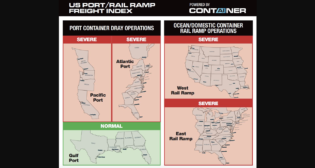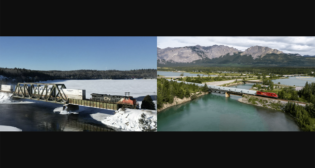
Northwest congestion spurs intermodal shift
Written by Bruce E. Kelly, Contributing EditorHistorically high levels of traffic, plus numerous track and capacity improvement projects that are currently under way, are both putting the squeeze on BNSF's northern corridor, with intermodal a potential casualty.
The effects have rippled through every class of business the corridor handles. First it was Amtrak, whose Empire Builder service (Chicago to Seattle and Portland) suffered such chronic delays over the past year that it temporarily altered its Spring 2014 schedule in an effort to better serve its customers and integrate more smoothly with BNSF traffic. Then it was agriculture, most notably grain shippers, who say their 2013 harvest is not getting transported as promptly as crude oil and other commodities.
Now it’s intermodal that’s feeling the heat. Containers and trailers, both domestic and international, account for nearly one-third of the trains that BNSF moves into and out of the Pacific Northwest. West of Spokane, Wash., the majority of that intermodal traffic is processed through terminals in Seattle and Tacoma. A smaller portion is handled through Portland, Ore.
BNSF’s high-priority Z trains, which convey primarily domestic intermodal across South Seattle-Chicago and Portland-Chicago lanes via the northern corridor, were once able to complete their trip in roughly 72 hours. But now, according to BNSF’s Expedited Trailer Service Goals posted May 2, 2014, service on those two lanes is expected to take anywhere from 119 to 135 hours.
The longest run times are being felt on the Chicago-Portland side, ironically due to the massive work being done to install nearly 20 miles of new sidings and second main track between Spokane and Pasco, Wash., and the resulting traffic back-ups created by those projects. Part of a $235-million investment BNSF is making in Washington state alone, that track work will ultimately restore fluidity to a route that is vital not only to intermodal but also to manifest freights and unit trains of grain, coal, and crude.
Until that fluidity is back, BNSF is moving its Portland-Chicago intermodal and some of its South Seattle-Chicago intermodal as Q symbols (train Q-PTLCHC from Portland to Chicago, for example) which reflect the current five- to six-day transit time. BNSF has also taken the dramatic step of shifting some of its trailers to highway transport for the Spokane-Portland and Spokane-Seattle legs.
With its Northwest capacity momentarily compromised, it was inevitable that BNSF would be challenged for a slice of its much-envied business. Union Pacific has announced it will add a new premium intermodal service, with a four-day transit time, between Portland and its Global 1 terminal in Chicago beginning May 8. UP already offers service between Portland and its Global 2 (Chicago) terminal.
“Adding these new trains required minor adjustments to other service schedules,” says UP.
At the annual shareholders meeting of BNSF parent Berkshire-Hathaway on May 3, rail congestion was among the topics of discussion. BNSF first-quarter net earnings were down 9.3% at $724 million, compared to $798 million the previous year. Berkshire-Hathaway attributes that to severe winter weather, as well as the ongoing struggle between traffic demand and capacity-expansion projects.
“Nevertheless, we expect that revenues and earnings over the remainder of 2014 will exceed 2013,” B-H says.



